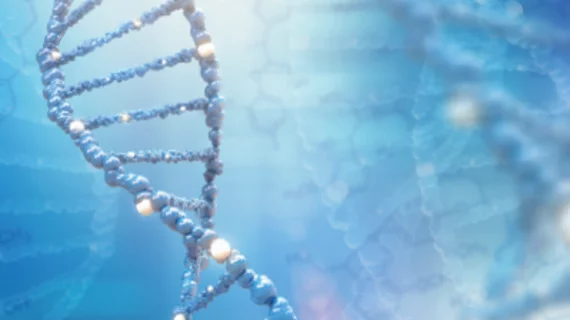Genetic variant linked to chemotherapy-induced cardiomyopathy
The same genetic variants that have been uncovered in patients with two other types of cardiomyopathy are also present in an uncommonly high proportion of people with cancer therapy-induced cardiomyopathy (CCM), researchers reported in Circulation.
Truncating variants in the TTN gene (TTNtv) were found in 7.5% of the 213 patients with CCM who were recruited from three different cancer cohorts—two groups of adults (mostly with breast cancer) and one of children with acute myeloid leukemia. Combined, their prevalence of TTNtv far outpaced the proportion of the variants which were found in phenotyped populations of cancer patients without therapy-induced cardiomyopathy (1.1%), healthy volunteers (0.7%) and an ancestry-matched reference population (0.6%).
TTNtv were previously detected in about 15% of patients with peripartum cardiomyopathy and 9.9% of those with alcoholic cardiomyopathy, noted lead author Pablo Garcia-Pavia, MD, PhD, and colleagues.
“The identification of genetic risk factors opens new opportunities to define patients at high risk for CCM and associated adverse outcomes,” wrote Garcia-Pavia, with the department of cardiology at Hospital Universitario Puerta de Hierro in Madrid, and co-authors. “Future investigations to define cancer patients with high risk for CCM through genetic testing can assess the efficacy of prophylactic cardioprotective drugs and/or treatment regimens to reduce CCM while providing effective cancer therapy.”
Cancer treatments, including chemotherapeutic agents, have helped to improve survival rates from the disease, but as long-term survival rates have gone up, another problem has emerged: cardiotoxicity among survivors. Greater cumulative drug exposures and pre-existing cardiovascular diseases have been associated with higher risks for developing CCM, but Garcia-Pavia et al. hypothesized that genetic variants could be another key in explaining individuals’ susceptibility to the condition defined by reductions in left ventricular ejection fraction (LVEF).
That hypothesis appeared to hold up, the researchers found, although they said their results should be confirmed in more studies with patients of diverse ancestries.
Adult CCM patients with the genetic variants in their study had significantly more heart failure hospitalizations and atrial fibrillation than those without TTNtv. Even though baseline LVEFs were similar in both groups, those with TTNtv had lower average LVEFs after diagnosis and follow-up (39.6% vs 48.9%). Average LVEF recovered by 4.7% for patients with TTNtv and 12.1% among those without.
The researchers also performed a complementary, experimental analysis on mice, in which they administered anthracycline treatments for four weeks to mice with a TTNtv as well as a control group. Like the humans, the mice with TTNtv showed sustained left ventricular dysfunction through 12 weeks, while wildtype mice without the variant saw their LVEFs bounce back by week eight.
“In vitro analyses of human isogenic cardiomyocytes (derived from induced pluripotent stems cells) demonstrate that titin provides an essential mechanical connection that propagates diastolic traction stresses from β-cardiac myosin during sarcomere formation,” Garcia-Pavia and colleagues wrote. “Cardiomyocytes with TTNtv have diminished re-assembly of sarcomeres after stress in comparison to cells without TTNtv. We suggest that chemotherapy, like pregnancy and excessive alcohol is an important provocation that is poorly tolerated by TTNtv, a conclusion that is supported both by these human data and analyses of anthracycline-treated TTNtv mice.”
Related Cancer Therapy Cardiotoxicity Content:
Succeeding with Cancer: Using Imaging to Avoid Treatment-induced Heart Failure
Providers must rethink traditional imaging approaches to prevent cardiotoxicity in cancer patients
CV programs struggling to keep up with growing demand for cardio-oncologists
Machine learning predicts drug cardiotoxicity
Prior cardiotoxicity linked to 30% increased risk of CHF during pregnancy
CV outcomes underreported in pivotal anticancer trials
CDK2 inhibitors protect cancer patients from anthracycline-induced cardiotoxicity
Genetic variants could be key to identifying chemo-induced cardiotoxicity
T2 mapping may uncover cardiotoxic marker early enough to prevent heart failure
Some chemo drugs might be more heart-safe than others
Cardiac MRI-derived T2 mapping may help heart failure patients
Study calls for better collaboration between cardiologists, oncologists
Cardiac monitoring may protect high-risk breast cancer patients against heart failure

